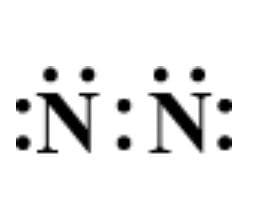
Which of the following is the correct representation of electron dot structure of nitrogen?

A.

B.

C.
D.





Answer
574.8k+ views
Hint: Chemical bonding refers to the formation of a chemical bond between two or more atoms, molecules, or ions to give rise to a chemical compound. Moreover, these chemical bonds are what keeps the atoms together in the resulting compound.
Complete step by step answer:
-Albert Kossel and Gilbert Lewis were the first to explain the formation of chemical bonds successfully in the year 1916. Further, a Lewis theory of chemical bonding was given. Some of the points of this theory are given below:
1.An atom can be viewed as a positively charged Kernel and as the outer shell.
2.The outer shell can accommodate a maximum of eight electrons only.
3.Atoms can achieve the stable configuration by forming chemical bonds with other atoms. 4.Moreover, this chemical bond can be formed either by gaining or losing an electron or in some cases due to the sharing of an electron.
Generally, the valency of an element is either equal to the number of dots in the corresponding Lewis symbol or eight minus the number of dots.
Now, let’s determine the electron dot structure of nitrogen. The atomic weight of nitrogen is and its electronic configuration is $1{s^2}2{s^2}2{p^3}$ . Thus, three electrons remain in the ‘p’ orbital which forms the extremely strong triple bond in elemental nitrogen. Hence, its structure is represented as:

Hence, option D is correct.
Note:
Atoms having eight electrons in their last orbit are stable and have no tendency to react whereas the atoms having less than eight electrons react with other atoms to get eight electrons in their outermost orbit and become stable. Moreover, the atoms that cannot either lose or gain electrons may share to get the octet configuration.
Complete step by step answer:
-Albert Kossel and Gilbert Lewis were the first to explain the formation of chemical bonds successfully in the year 1916. Further, a Lewis theory of chemical bonding was given. Some of the points of this theory are given below:
1.An atom can be viewed as a positively charged Kernel and as the outer shell.
2.The outer shell can accommodate a maximum of eight electrons only.
3.Atoms can achieve the stable configuration by forming chemical bonds with other atoms. 4.Moreover, this chemical bond can be formed either by gaining or losing an electron or in some cases due to the sharing of an electron.
Generally, the valency of an element is either equal to the number of dots in the corresponding Lewis symbol or eight minus the number of dots.
Now, let’s determine the electron dot structure of nitrogen. The atomic weight of nitrogen is and its electronic configuration is $1{s^2}2{s^2}2{p^3}$ . Thus, three electrons remain in the ‘p’ orbital which forms the extremely strong triple bond in elemental nitrogen. Hence, its structure is represented as:

Hence, option D is correct.
Note:
Atoms having eight electrons in their last orbit are stable and have no tendency to react whereas the atoms having less than eight electrons react with other atoms to get eight electrons in their outermost orbit and become stable. Moreover, the atoms that cannot either lose or gain electrons may share to get the octet configuration.
Recently Updated Pages
Why are manures considered better than fertilizers class 11 biology CBSE

Find the coordinates of the midpoint of the line segment class 11 maths CBSE

Distinguish between static friction limiting friction class 11 physics CBSE

The Chairman of the constituent Assembly was A Jawaharlal class 11 social science CBSE

The first National Commission on Labour NCL submitted class 11 social science CBSE

Number of all subshell of n + l 7 is A 4 B 5 C 6 D class 11 chemistry CBSE

Trending doubts
Differentiate between an exothermic and an endothermic class 11 chemistry CBSE

10 examples of friction in our daily life

One Metric ton is equal to kg A 10000 B 1000 C 100 class 11 physics CBSE

Difference Between Prokaryotic Cells and Eukaryotic Cells

1 Quintal is equal to a 110 kg b 10 kg c 100kg d 1000 class 11 physics CBSE

State the laws of reflection of light




